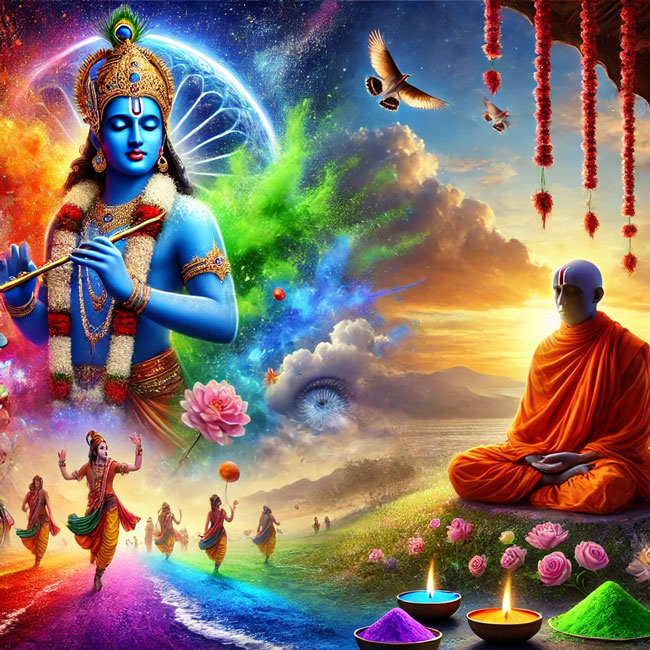Creation is merely a play—of passion and colors. During the month of Phalguna, this play reaches its peak.  Nature reveals its enchanting and mesmerizing beauty, stirring emotions within living beings. When these inner stirrings manifest outwardly, they take the form of celebrations, and thus, the festival of colors—Holi—is celebrated.
Nature reveals its enchanting and mesmerizing beauty, stirring emotions within living beings. When these inner stirrings manifest outwardly, they take the form of celebrations, and thus, the festival of colors—Holi—is celebrated.
The Significance of Colors
Three colors hold primary importance—red, green, and blue. All other colors in the world can be created from these three. The most attention-grabbing color is red, as it is the brightest and most energetic. Red generates the highest vibrations in human consciousness. It is the color of enthusiasm and vigor. If a person wears red clothing, they appear more energetic, even if they are not actually feeling that way.
The Goddess and the Color Red
The Goddess (the feminine aspect of consciousness) symbolizes this energy and enthusiasm. Her energy radiates immense vibrations and power. The practice of Goddess worship often involves the use of red, as it represents vitality and strength.
The Color Blue: A Symbol of Inclusion and Vastness
Blue is the color of inclusion. Anything vast and beyond human comprehension in this universe is usually blue, like the sky and the ocean. It represents expansiveness and depth. Lord Krishna is often depicted as having a blue complexion. This does not necessarily mean his skin was blue; rather, those who were spiritually aware perceived the energy around him as blue.
The Color Black: The Absorber of Energy
Black appears black because it does not reflect any light; instead, it absorbs everything. If a person continuously wears black clothes and interacts with different environments, they may find their energy fluctuating, affecting their mental stability. However, in a place of positive and high spiritual energy, black is the best color to wear, as it absorbs the maximum beneficial energy.
White: The Presence of All Colors
White is, in reality, not a color but the presence of all colors combined. Those on the spiritual path often wear white as they wish to participate in life without accumulating attachments.
The Color Saffron and Detachment
Saffron or ochre represents spirituality and wisdom. It is the color of the Ajna chakra, which signifies spiritual awakening. Monks and renunciates wear this color because it symbolizes detachment and the pursuit of higher consciousness.
Passion, Colors, and Detachment
Passion is synonymous with color, and what lies beyond color is not colorless but transparent. Detachment means not holding onto anything, becoming transparent. A detached person can adapt to any situation without being influenced by it. If surrounded by red, they appear red, and if surrounded by blue, they appear blue, but the color never clings to them. This is why detachment is emphasized so much in spirituality.
The Completeness of Life
We cannot truly experience the completeness and true joy of life until we transcend the realm of passion and colors. The highest spiritual experience lies in going beyond colors and recognizing the essence of the self.




